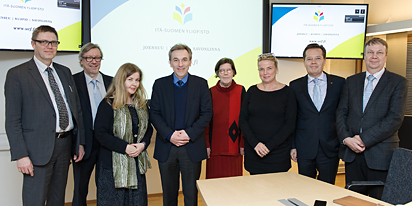
CMRR
Center for Magnetic Resonance Research, Department of Radiology
News
You are here
Fulbright-Saastamoinen Foundation Grant speeded up development of safer deep brain stimulation

May 21, 2015 A new Fulbright-Saastamoinen Foundation Grant award supports Professor Shalom Michaeli's research.
A Fulbright-Saastamoinen Foundation Grant of six months gave a boost for cooperation between Professor Shalom Michaeli and one of his research partners, the Kuopio-based research group of Professor Olli Gröhn. "Using functional magnetic resonance imaging (fMRI), we have been developing a new method for deep brain stimulation of patients with, for example, Parkinson's disease. Furthermore, we've also launched new projects," Michaeli says.
Working at the Center for Magnetic Resonance Research, CMRR, at the University of Minnesota, the Fulbright-Saastamoinen Foundation Grant made it possible for Michaeli to spend six months on the Kuopio Campus of the University of Eastern Finland. "The university has a unique approach to combining expertise in neurosciences and magnetic resonance imaging, and we've carried out several joint projects already before."
The CMRR, on the other hand, is one of the world's leading research centres in high field magnetic resonance imaging.
The new joint project focuses on deep brain stimulation, DBS, used in the treatment of Parkinson's disease, for example. In DBS, an electrode or electrodes are implanted into the brain, and electrical impulses are sent to the brain via them.
"Deep brain stimulation is effective in reducing tremor and improving coordination, but the mechanism isn't fully understood yet. The present method also involves problems such as tissue damage due to heating," Michaeli explains.
Together with Gröhn's research group, he's been developing a more selective, increasingly effective and safer DBS method. The new method is based on a rotating electric field, allowing the control of not only the frequency and amplitude of the electrical impulse, but also its direction. This enhances treatment effectiveness and reduces adverse effects. Furthermore, new types of electrodes, with patent currently pending, have also been developed for the purpose in cooperation between Michaeli's and Gröhn's groups. The effects of the new method are studied with the help of magnetic resonance imaging in animal models.
During Michaelis's grant period, two other joint projects have also been initiated. One of the projects aims to develop magnetic resonance imaging of white matter changes associated with Parkinson's disease and multiple sclerosis by using novel contrasts. The other project focuses on the basic mechanisms of magnetic resonance imaging contrasts in brain tissue samples of patients with Parkinson's disease.